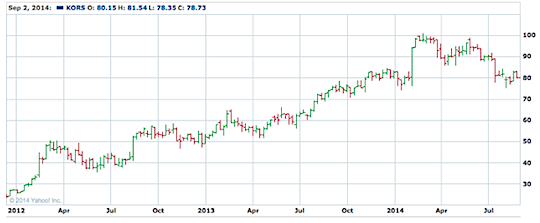Could Interest Rates Stay Low Forever Cabot Investing
Post on: 16 Март, 2015 No Comment

Why Did this Good News Make the Market Tumble Last Week?
Crying Wolf on The Fed
Could Interest Rates Stay Low Forever?
— Advertisement —
They Laughed When I Bought Tesla
Last year, when we told our Cabot Top Ten Trader readers to back up the truck and buy Tesla with both hands, we got a lot of flak from my colleagues in the trading world.
But now that its handed our readers 600% profits, its no wonder why Cabot Top Ten Trader is considered Wall Streets leading trading advisory.
As youll see in this week’s Cabot Top Ten Trader. our latest top 10 trades are no joke either.
Get the entire buy list FREE tonight and see for yourself. Click here for details.
The market performed well overall last week, but Thursday morning saw dramatic gaps down in all three major indexes. The S&P 500 closed Wednesday just above 2000, then opened Thursday at 1997, before falling as low as 1990.5.
Watching the market Thursday morning, you could be forgiven for assuming that the indexes were reacting to some pretty bad news.
In fact, just the opposite was happening. The Commerce Department had just released a report announcing that the economy grew 4.2% in the latest quarter, better than their initial estimate, and way better than the shrinkage of -2.1% seen in the first quarter. In addition, the number of new applications for unemployment benefits fell again last week, the Labor Department said Thursday. Average weekly unemployment claims are now at their lowest level since 2006.
Sounds like good news!
And yet the market fell. Better-than-expected economic growth triggering a selloff seems counterintuitive, but it was not the least bit surprising to investors who have seen it happen dozens of times in the last five years. So why is economic growth now greeted as a negative for the stock market?
The Fed has been keeping interest rates low since the 2008 crash, to try to encourage banks to lend, businesses to hire and consumers to spend. It seems to be working, slowly, but the Fed still wants to see more economic growth and more hiring before they turn down the money spigot. Fed Chairwoman Janet Yellen has been particularly vocal about needing to see a more vigorous labor market before touching interest rates.
Her frankness is supposed to be reassuring, but it also has the perverse effect of making good economic numbers unwelcome, because investors know that economic improvement will eventually lead to higher interest rates. And theyre worried that higher interest rates will slow down economic growth and the stock markets advance.
This perverse reaction to good economic news, and good employment statics in particular, has become both commonplace and expected during the multi-year recovery since the recession ended.
One of the most dramatic selloffs occurred in May 2013, when speculation about the Fed tapering its bond-buying program caused 10-year treasury rates to rise from 1.6% to 2.2% in a month. Indexes tracking interest-rate-sensitive securitiesREITs most notablyplummeted.
A writer summarizing the selloff for Zacks wrote, The reaction to just a hint of talk at reducing bond purchases is certainly troubling.
Now, 15 months later, tapering is well underway, and is scheduled to conclude in October. And yet, the 10-year treasury rate is lower than it was at the beginning of the year. REITs and many other interest-rate-sensitive securities are doing quite well too. (Our best-performing Cabot Dividend Investor position is a REIT, up 30% in the six months weve owned it.)
So, do I think the Feds first interest rate increase since 2006, when it happens, will mean the end of the bull market and a halt to economic expansion?
Nope.
The interest rate increasewhich is expected to be a mere quarter of a percent bumpis probably in the top 10 most highly anticipated market events ever. (Personally I cant think of anything to rival it, but I havent been around that long.) And as my dad likes to say, Trouble comes from where you least expect it. To give you an idea of just how expected this event is, heres an excerpt from an article on interest rates written almost five years agoin early October 2009by fixed-income expert Bob Brinker. Brinker wrote:
We have been saying for some time subscribers should avoid U.S. Treasuries, especially longer-term maturities. We expect the Fed will hold short-term interest rates at exceptionally low levels well into 2010. We also expect the tsunami of supply of longer-term Treasury securities will eventually weigh on Treasury prices, resulting in yields gradually drifting higher throughout 2010.
Heres a 10-year chart of 10-year Treasury yields, with an arrow pointing to October 2009, when Brinker wrote his article.
As you can see, the yields on 10-year treasuries actually spent most of 2010 falling even further. Then they kept fallingfor three more years.
I know 2009 doesnt feel that long agoI remember it clearly. I remember reading predictions like this one, made by StreetAuthoritys Nathan Slaughter in December 2009, like it was yesterday:
Im not going to spend too much time today trying to convince you that interest rates are headed higher. We covered that topic extensively last month. The Fed Funds rate has been slashed to near zero, so theres really only one direction rates can goand thats up.
But 2009 was five years ago, and that is a long time for the market to be waiting for something to happen. Especially when its been anticipating it as breathlessly as investors have been anticipating the interest rate increases. To see what I mean heres one more gem from Slaughter circa December 2009:

Were only here now because the Fed had to dispense an emergency dose of monetary drugs to keep the U.S. economy from flat-lining. But the patient has begun to recuperate, and sooner or later Bernanke and the Fed will have no choice but to stop the medicine. Keep in mind, we have a long way to go just for interest rates to return to normallet alone elevated levels needed to choke off inflation. So once the rate tightening cycle begins, dont expect to see just one or two quarter-point hikes. The last time rates sunk to 1.00% in 2004, they were ratcheted upward 17 times during the next two years.
— Advertisement —
Reserve Your Spot Today
Our Limited Cabot Dividend Investor membership is now open for the next 24 hours only. We only have 50 spots available, so if you missed your chance to join us back in April, now is the time to reserve your spot.
But hurry, this offer is available to our Cabot Wealth Advisory readers only and will expire in 24 hours or when all spots have been taken.
Seventeen rate hikes in two years is a far cry from the falling yields we wound up getting in 2010 and 2011. (On a side note, one thing investors have mostly stopped worrying about in the intervening four years is inflation.) And as their predictions were proven wrong, the experts did start changing their tunes and softening their tones.
FOMC members are now predicting a gradual pace for interest rate hikes, and a normalizing of the rate closer to 3% than the 4% we got used to in previous decades. Most experts are now calling for the same thing, revising their earlier calls for fast and furious interest rate increases. The revision is to their credit. But have they really learned?
Of the 90 different institutions whose interest rate predictions Bloomberg tracks, only one is predicting that interest rates will be lower in a year.
Even more worrisome than the fact that 89 out of 90 experts are sticking with the same prediction theyve been wrong about for five years is that fact that 89 out of 90 experts agree.
If 89 out of 90 dentists agree that you should floss, you should probably floss.
If 89 out of 90 experts agree about something in the stock market.
Well, as my father, the best contrarian I know, says: When everybody believes something, everybody is likely to be wrong.
About the Author
Chief Analyst of Cabot Dividend Investor
Chloe Lutts Jensen is the chief analyst of Cabot Dividend Investor. and the third generation of the Lutts family to join the family business. She is also a regular contributor to Cabot’s free e-newsletter, Cabot Wealth Advisory .














